
1776-1799 NYC: America's Beginnings: An Era of Historic Milestones
In the late 18th century, New York City embarked on a transformative journey following the American Revolution, shaping its identity amidst a backdrop of post-war reconstruction and renewal. The period spanning from 1776 to 1799 witnessed the city’s resilience and determination to rebuild after the tumult of conflict, positioning itself as a resilient urban center with a renewed sense of purpose. Leveraging its strategic location, New York City solidified its status as a pivotal hub of commerce and trade, playing a crucial role in the economic fabric of the burgeoning nation.
Post-Revolution, New York City underwent a phase of urban revitalization, focusing on the restoration of infrastructure and the reimagining of its urban landscape. The city’s skyline evolved with the emergence of new architectural landmarks, reflecting a spirit of progress and growth. Streets were redesigned, trade routes expanded, and a palpable sense of optimism permeated the city as it embarked on a path of recovery and resurgence, symbolizing its resilience in the face of adversity.
Culturally, the late 18th century saw New York City continue to flourish as a melting pot of diversity, with successive waves of immigrants enriching its social fabric. The fusion of varied cultures and traditions contributed to the city’s vibrant tapestry, defining its cosmopolitan essence. This cultural amalgamation not only added depth to the city’s social landscape but also fostered a sense of inclusivity and shared identity among its diverse inhabitants.
Despite the challenges of war and the trials of reconstruction, New York City thrived as a symbol of resilience and innovation, embracing its role as a dynamic metropolis where diversity, progress, and opportunity converged to shape a narrative of growth and transformation. The city’s ability to adapt and evolve in the face of adversity underscored its capacity for reinvention and its enduring spirit of resilience, laying the foundation for its continued growth and prominence in the years to come.
Timeline of New York City’s History 1776-1799
Discover surprising historical facts about The City That Never Sleeps—explore fun, educational insights into its history, population, iconic landmarks, and more, perfect for students, history enthusiasts, and anyone curious about NYC’s rich heritage.
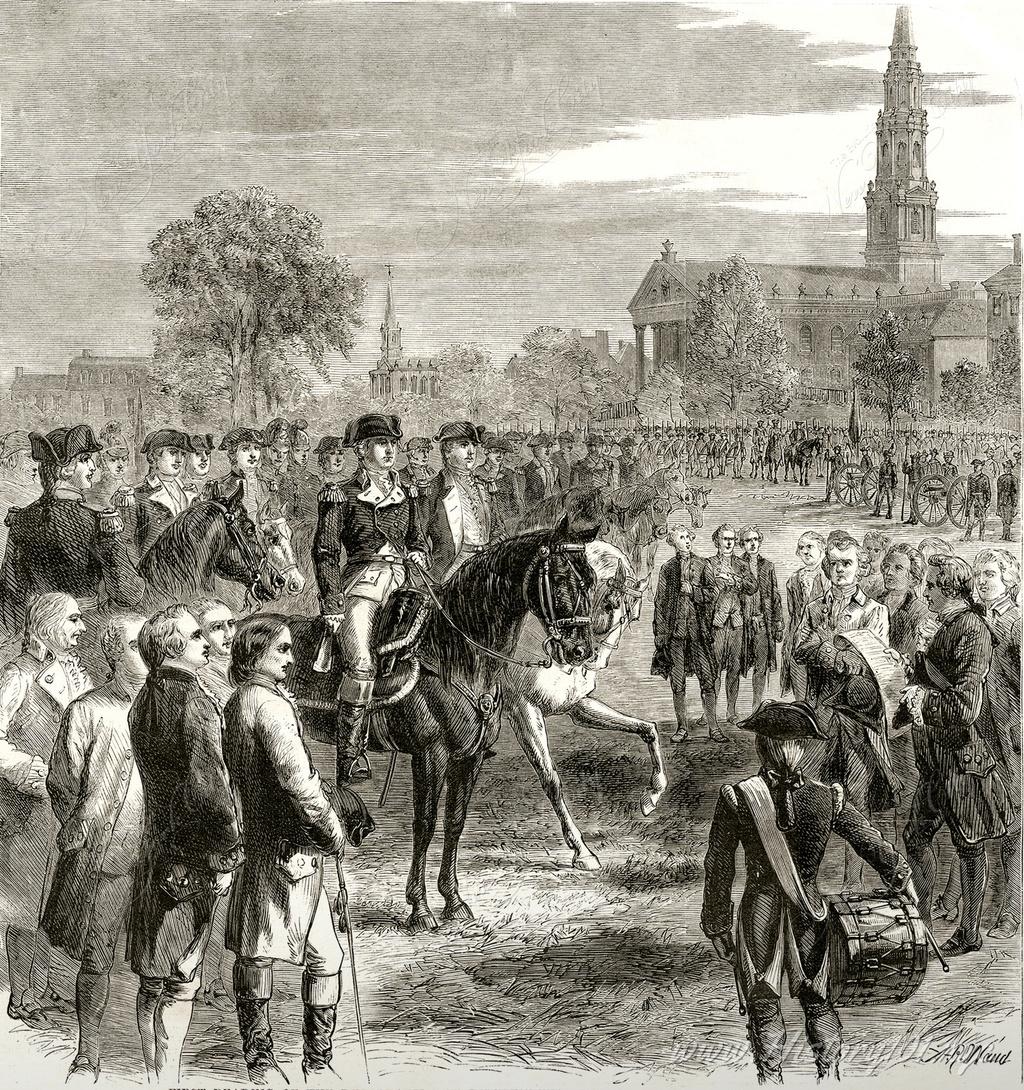
1776: George Washington’s Declaration Reading in NYC: A Defining Moment in American Independence
Discover how General Washington’s July 9, 1776 reading of the Declaration in NYC united citizens and shaped the fight for American independence
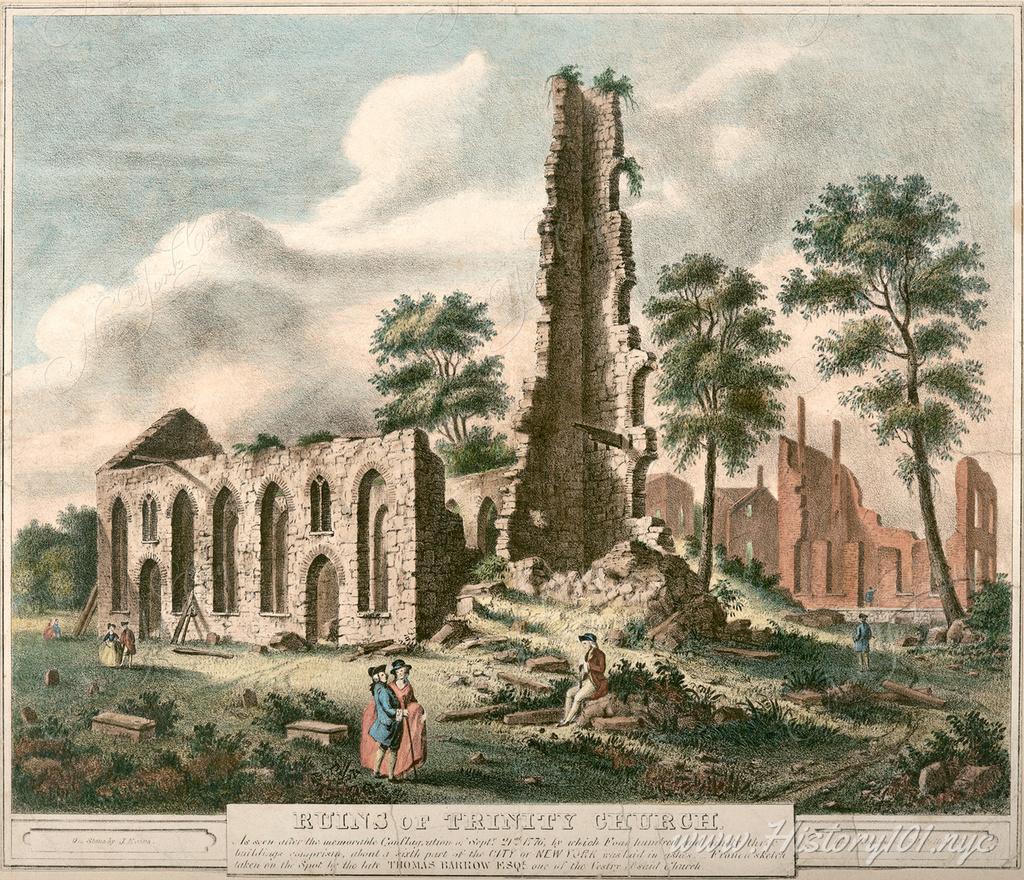
1776: The Great Fire of New York: Trinity Church's Ruins & City's Resilience
Discover the impact of the 1776 Great Fire of New York, including Trinity Church's destruction, through Thomas Barrow's evocative painting
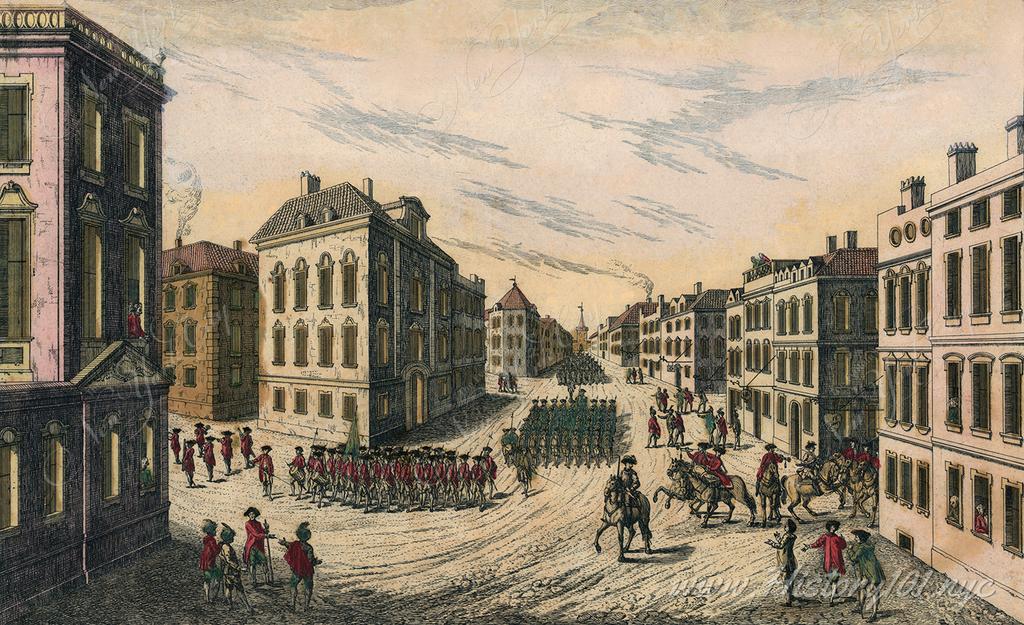
1776: British Occupation of NYC (1776-1783): The Battle of Long Island to Liberation
Explore the pivotal 1776-1783 British occupation of NYC, from the Battle of Long Island to its liberation
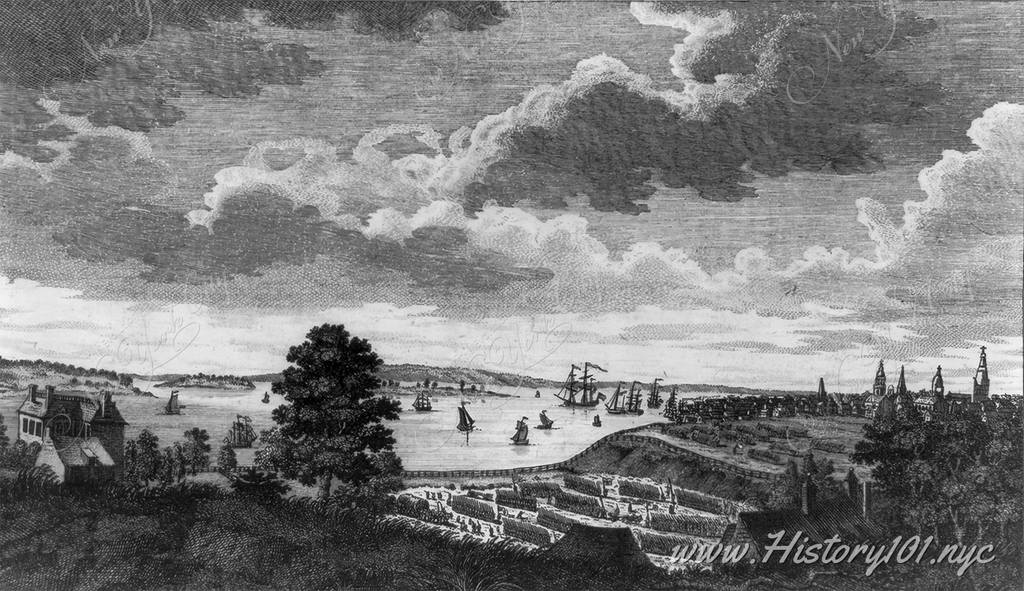
1776: Battle of Long Island: Canot's Artistic Insight into Revolutionary War History
Explore the Battle of Long Island through Canot's art, capturing New York's pivotal role in the Revolutionary War and Washington's leadership
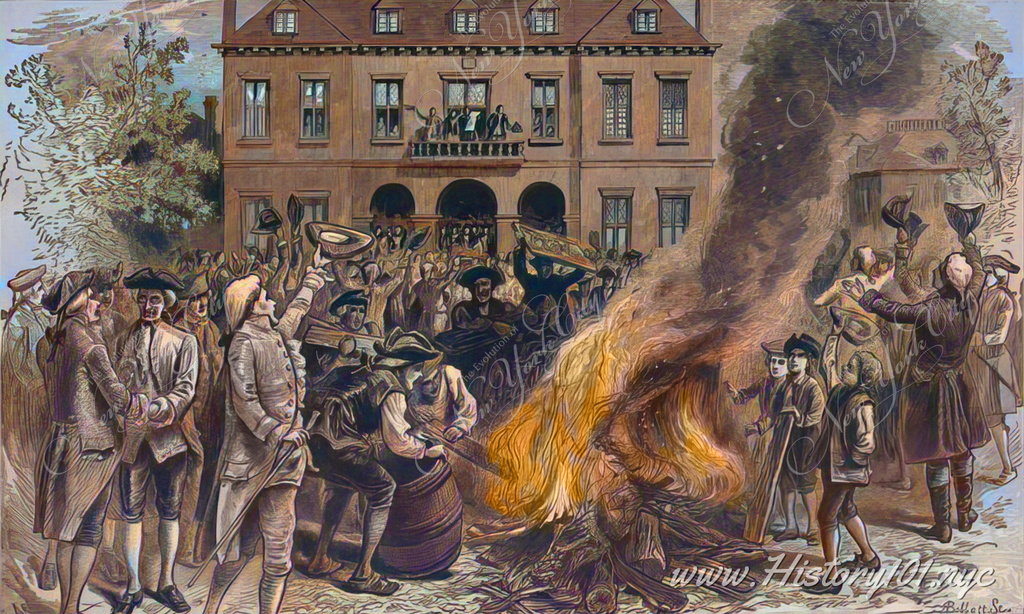
1776: New York City Defiance: Declaration Reading & King's Arms Burning
Discover the 1776 act of defiance in NYC, where the Declaration's reading and burning of the King's coat of arms marked a pivotal moment of unity and freedom
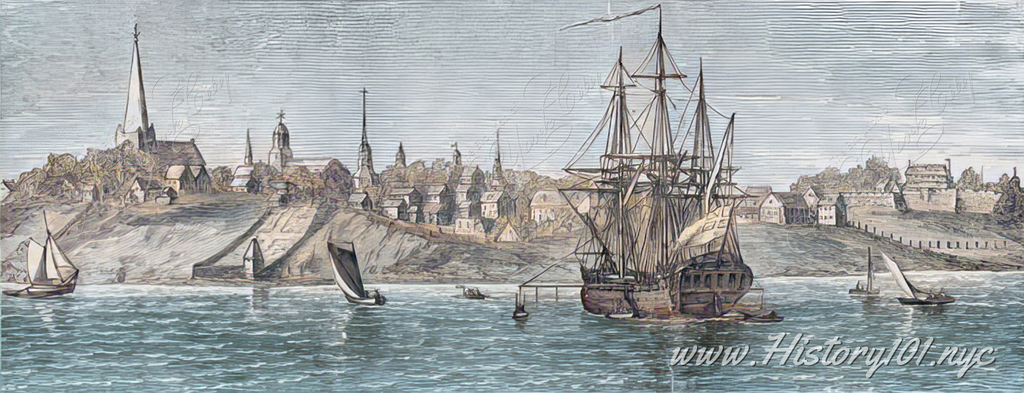
1776: New York City's Revolutionary Transformation & Maritime Emergence
Explore NYC's pivotal 1776 shift from colonial settlement to bustling port, marked by urban development and vital trade activities
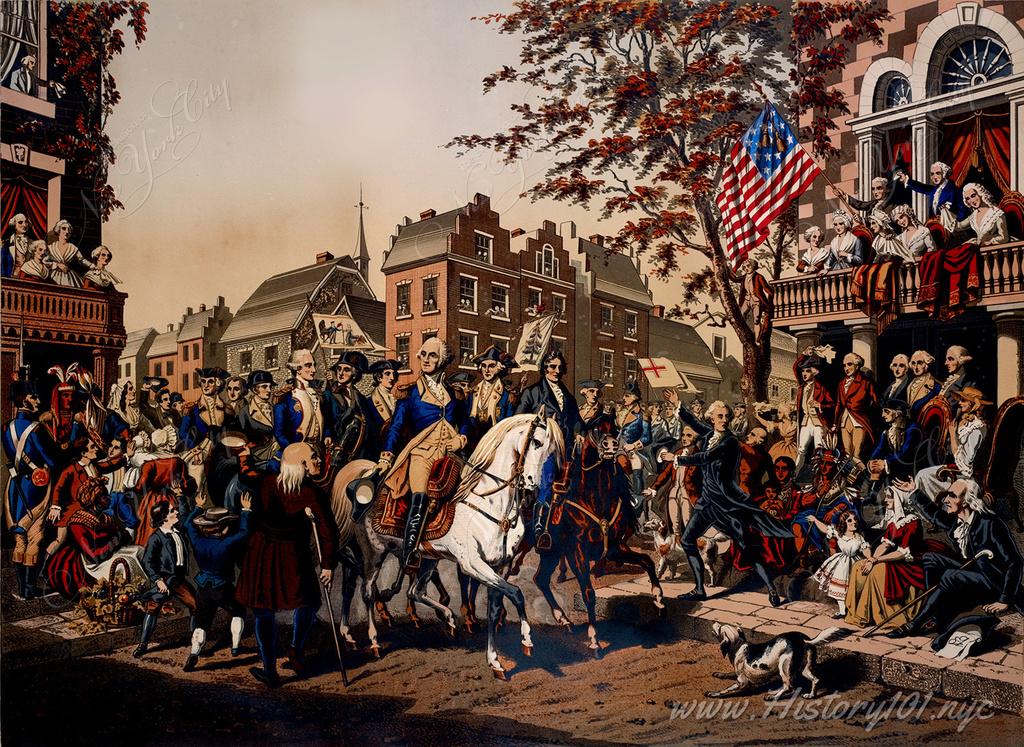
1783: Evacuation Day & George Washington's Role in Shaping Early New York City
Discover the impact of Evacuation Day 1783 and Washington's 1790 return on NYC's history, marking its transformation and early U.S. governance
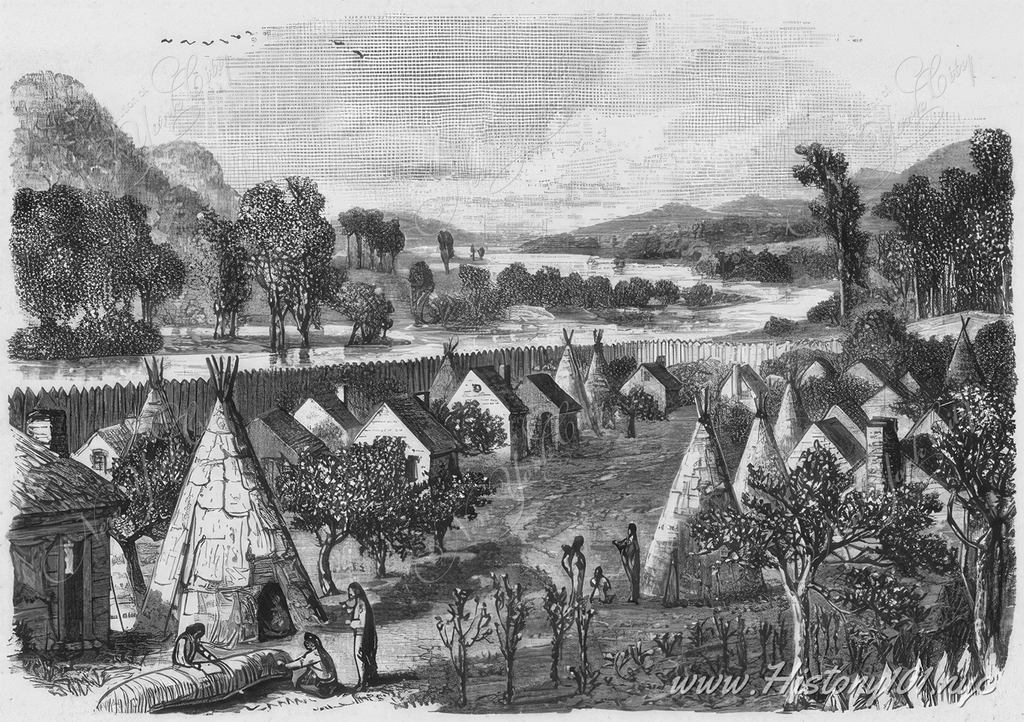
1780: Mohawk Legacy in NYC's Skyscrapers: From 18th Century Roots to Modern Heights
Discover the Mohawk 'Skywalkers' legacy, from their 18th-century origins in Central New York to shaping NYC's iconic skyline in the 20th century
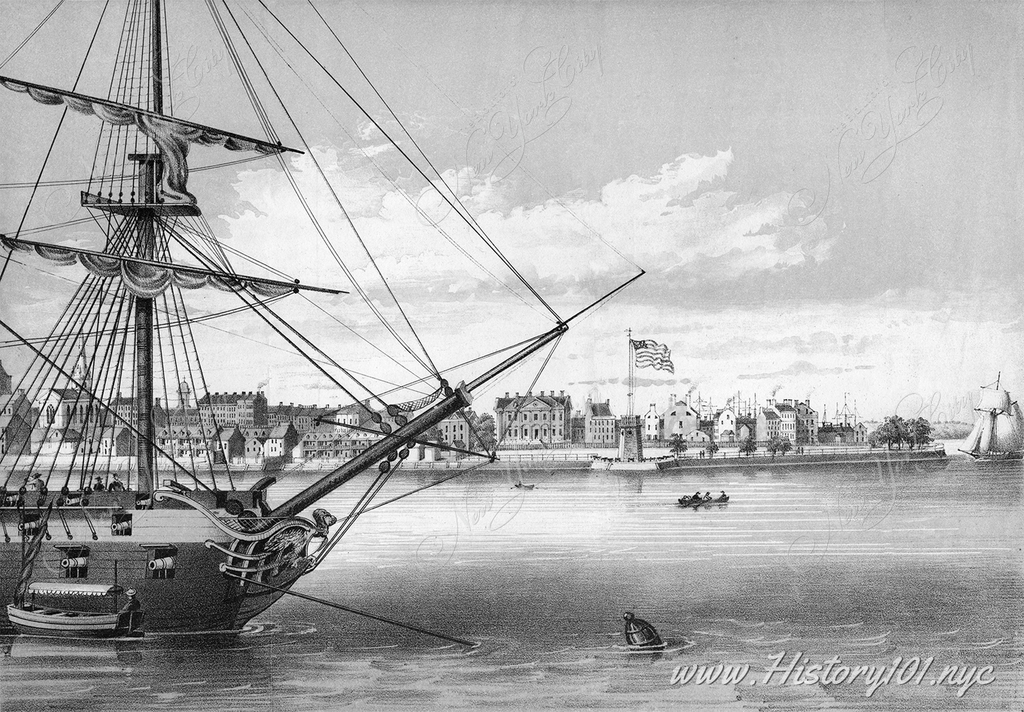
1787: Manhattan: The Pivotal Year Shaping NYC's Global Metropolis Future
"Discover Manhattan in 1787: A crucial year showcasing its transformation from a colonial outpost to a thriving hub in American history
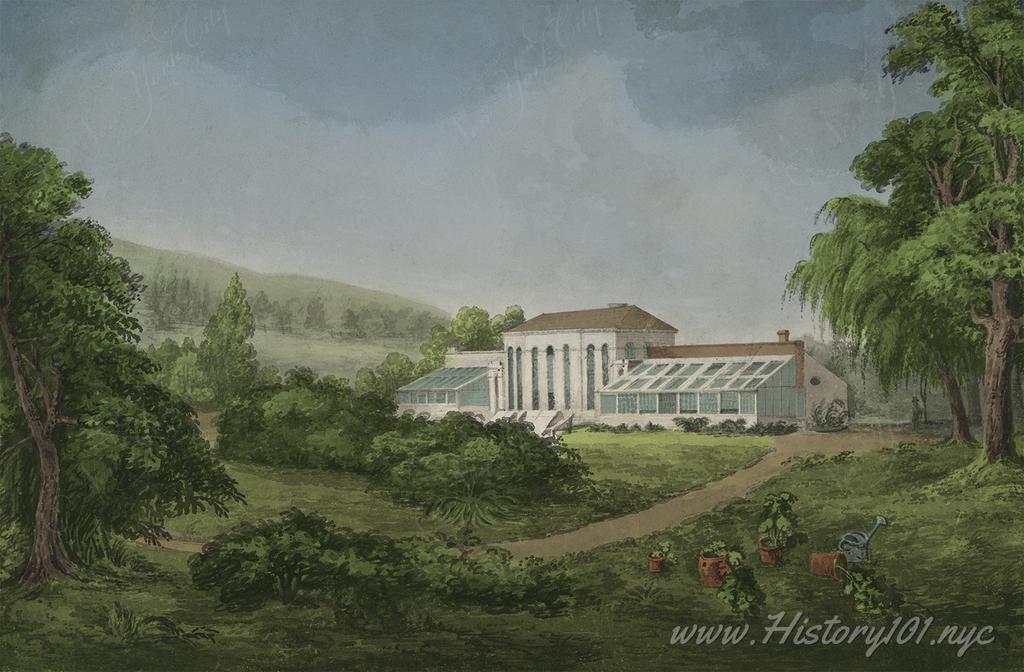
1788: From Elgin Botanic Garden to Rockefeller Center: Tracing New York City's Remarkable Urban Transformation
Explore the transformation of NYC's first botanical garden, Elgin, into the iconic Rockefeller Center, reflecting the city's dynamic evolution
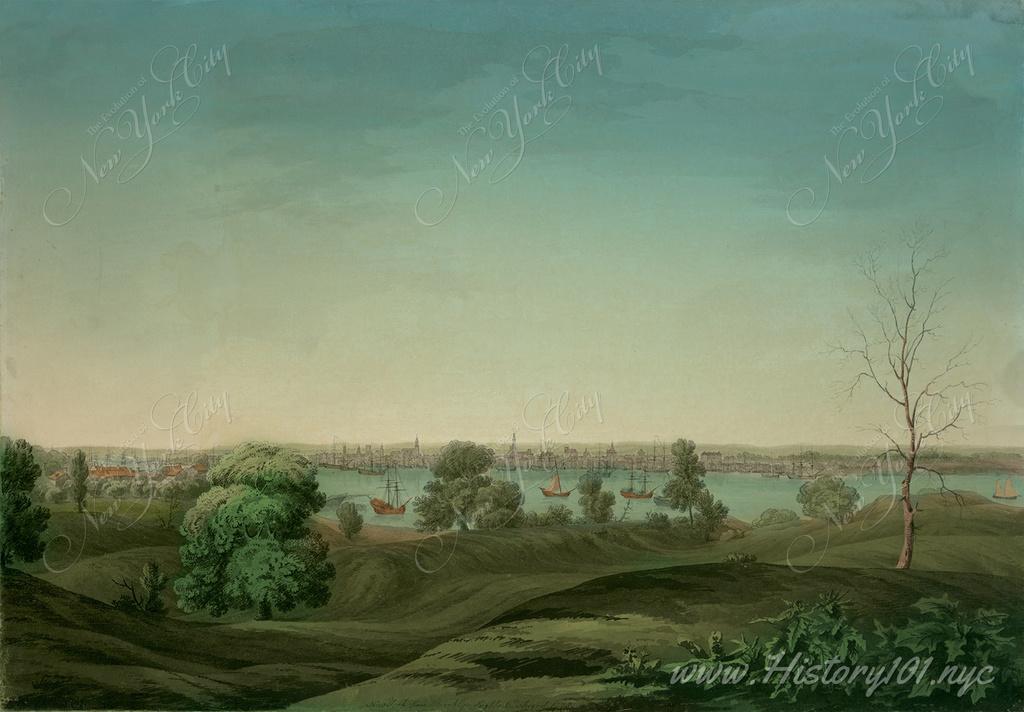
1778: Brooklyn Heights: A Journey from Native Settlement to Urban Promenade
Explore Brooklyn Heights' transformation from a 1778 native settlement to the modern Promenade, highlighting NYC's dynamic urban evolution
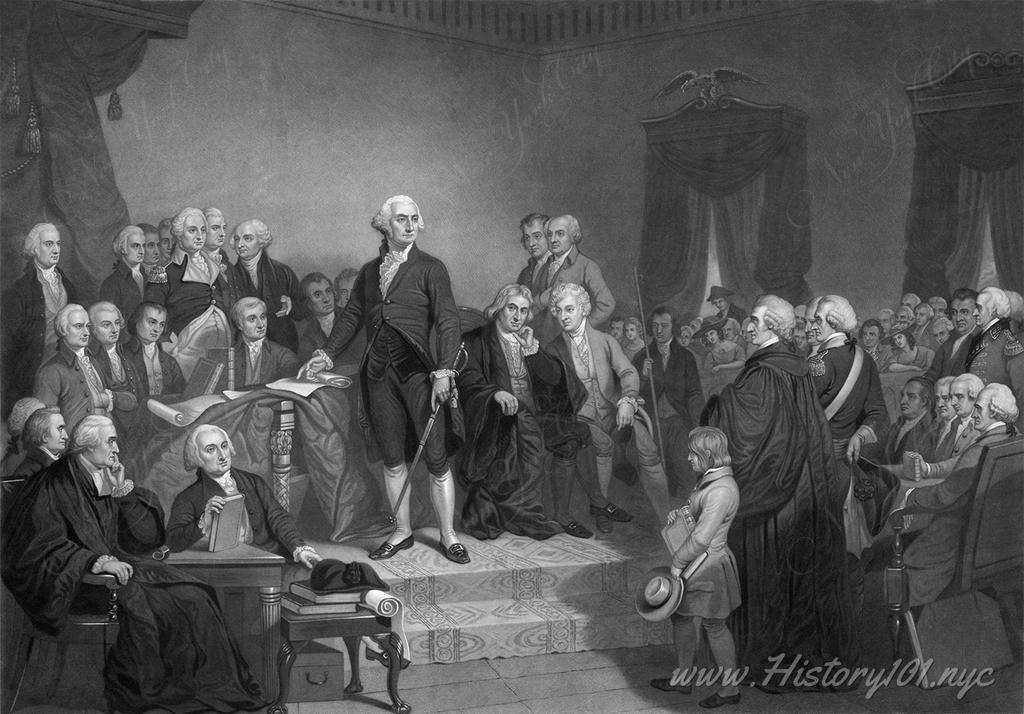
1789: Federal Hall & NYC's Legacy: George Washington's Inauguration and Early U.S. Capital
Explore George Washington's 1789 inaugural address at NYC's Federal Hall, a landmark event underscoring the city's role as the first U.S. capital
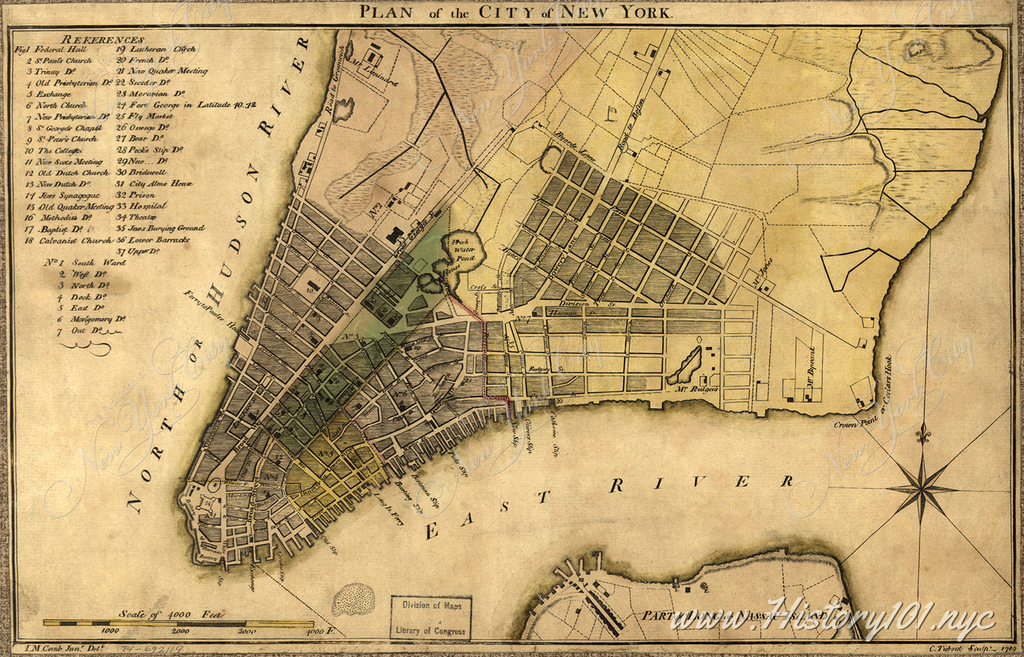
1789: The Maverick Plan: Charting New York City's Post-Revolutionary Transformation
Discover the Maverick Plan, a 1789 map revealing New York City's post-Revolution urban and commercial metamorphosis in striking detail
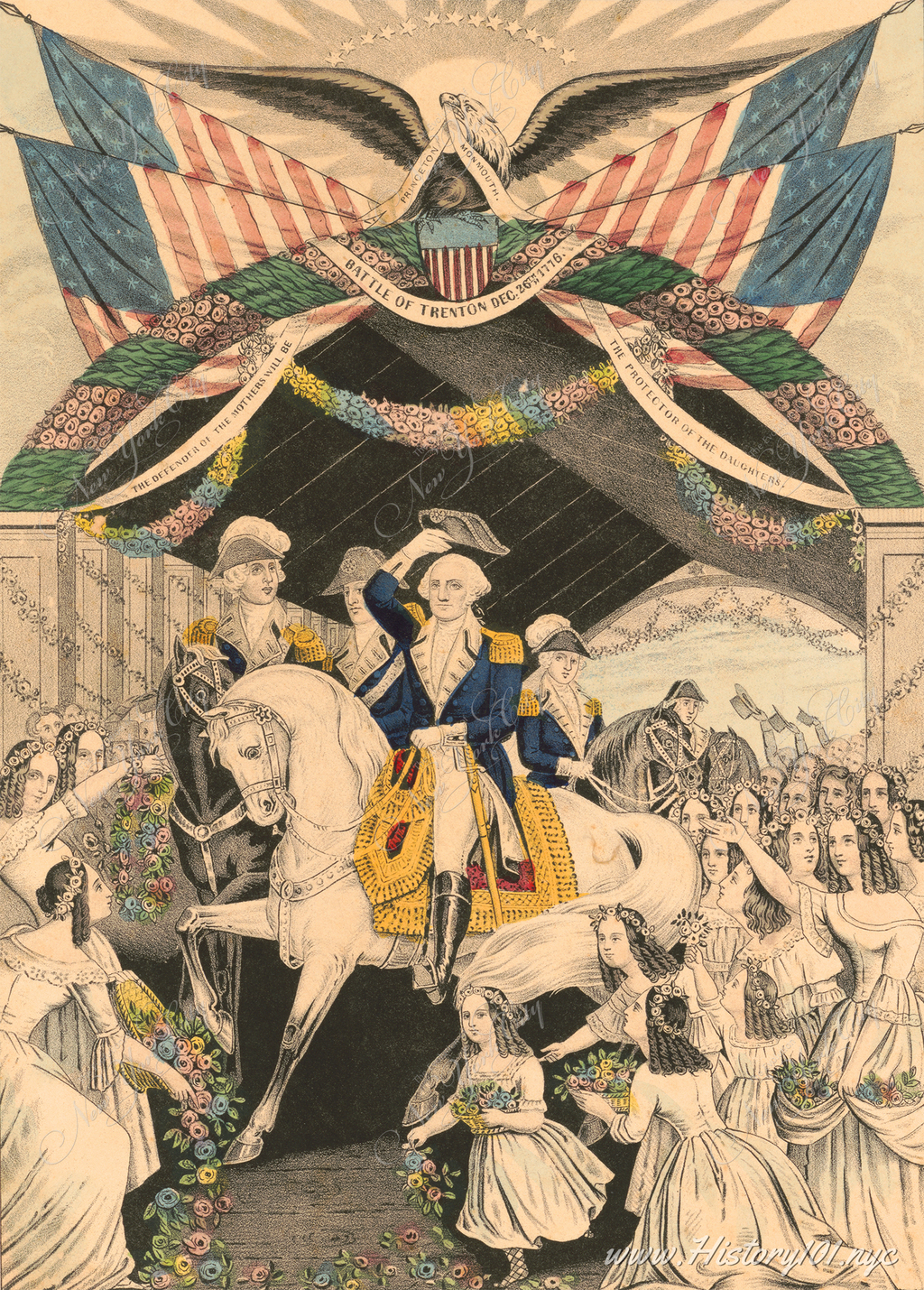
1789: Washingtons Reception
The illustration titled "Washington's Reception by the Ladies, on Passing the Bridge at Trenton, N.J." captures a momentous and symbolic event in American history.
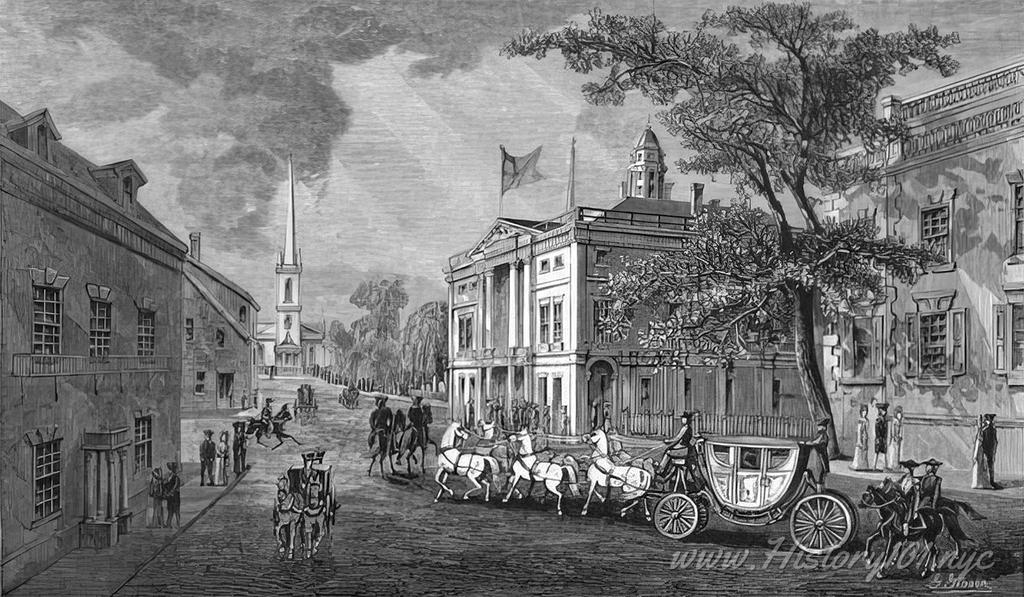
1790: George Washington in NYC: The Dawn of U.S. Presidency & Capital City
Explore the early U.S. government with George Washington's presidency in NYC, the initial capital, marking America's foundational era
Timeline of New York City: 1776-1799
1776: During the American Revolution, David Mathews became New York City's mayor, reflecting the city's Loyalist support for the British Crown in a time of intense political and military strife. Amid the Revolution's escalating conflict, Mathews' mayoral tenure underscored New York City's position as a center of tension.
On June 22, 1776, Mathews was arrested on suspicion of involvement in the Hickey Plot to assassinate George Washington, highlighting the era's espionage activities. This incident, involving Thomas Hickey of Washington's guard, underscores the fraught political climate and deep divisions in New York City. The extent of Mathews' role remains debated, but his arrest is emblematic of the dangerous intrigues and stark tensions during the Revolution's early stages.
1776: On July 2, the Second Continental Congress in Philadelphia passed the Lee Resolution, named after Virginia's Richard Henry Lee, officially declaring the Thirteen Colonies independent from British rule. This pivotal decision was followed by the adoption of the Declaration of Independence on July 4, outlining the reasons and principles for independence. While Independence Day is marked on July 4, the actual vote occurred on July 2.
In New York City, a key urban and strategic center, these July events were crucial. The city's significant port and location made it a prime target in the American Revolution. Following independence, British forces quickly captured New York City, profoundly impacting its residents and marking a challenging period of military occupation and conflict. This period was pivotal for New York's role in the struggle for independence and its place in the American Revolution narrative.
1776: On July 4, the Continental Congress ratified the Declaration of Independence in Philadelphia, a milestone in American history. Authored chiefly by Thomas Jefferson, it outlined the Thirteen Colonies' reasons for separating from Great Britain, emphasizing individual rights and self-governance. Independence Day, marking this ratification, is now a national U.S. holiday.
For New York City, a strategic port and key battleground in 1776, this ratification brought immediate challenges. British forces quickly captured the city post-Declaration, significantly affecting its residents and the American Revolutionary War’s trajectory. The Declaration's ideals of self-governance and the ensuing military occupation profoundly impacted New Yorkers, intertwining the city's fate with the struggle for American independence and the emerging national identity.
1776: On July 8, Philadelphia witnessed the Liberty Bell ringing in the Pennsylvania State House (now Independence Hall) to announce the first public reading of the Declaration of Independence, days after its July 4 adoption. This symbolic act marked the break from British rule, heralding the United States' emergence as an independent nation.
In New York City, the impact was immediate. On July 9, the Declaration was publicly read, spurring celebrations and revolutionary acts like the dismantling of King George III's statue in Bowling Green. These events in Philadelphia and New York were crucial, interconnected steps in the colonies' independence movement, significantly influencing the Revolutionary War and the United States' formation.
1776: On July 9, in New York City's Bowling Green, a pivotal moment in the American Revolution occurred with the first public reading of the Declaration of Independence to George Washington's troops. This event sparked a fervent act of rebellion when American soldiers and civilians dismantled a statue of King George III, erected in 1770 as a symbol of British rule.
This defiant act went beyond symbolism; the lead statue was melted into 42,000 musket balls for the Continental Army, blending political dissent with practical support for the war effort. The July 9 event at Bowling Green epitomizes the rejection of British authority and their dedication to independence, embodying the revolutionaries' spirit and ingenuity during the American Revolution.
1776: On August 27, the Battle of Long Island, or Battle of Brooklyn, marked the first major military conflict post-U.S. independence declaration. Taking place in present-day Brooklyn, then part of Long Island and New York City, the Continental Army, under General George Washington, faced the numerically superior British forces led by General William Howe, resulting in American tactical disadvantages and defeat.
This battle was a turning point for New York City in the Revolutionary War, leading to British occupation and altering the city's strategic significance. However, Washington's successful management of a strategic retreat saved the Continental Army from total defeat, maintaining its viability for future battles. This event underscored American resilience and strategic skills, setting the course for New York City's role in the Revolutionary War's remaining years.
1776: In a pivotal move post-Battle of Long Island defeat, General Washington masterfully orchestrated the Continental Army's stealth retreat to Manhattan on the night of August 29-30, 1776. Harnessing the cover of darkness and leveraging advantageous weather, the troops crossed the East River unseen by British forces.
This critical maneuver not only averted further casualties and the risk of a complete capture but also ensured the preservation of the Continental Army as a vital fighting entity. Consequently, it allowed the revolutionary forces to persist in their quest for American independence, marking a significant strategic victory in the early stages of the struggle.
1776: On September 15, during the American Revolutionary War, British forces captured lower Manhattan following the Landing at Kip's Bay. This overwhelming display of military strength compelled General George Washington to strategically retreat from New York City with the Continental Army, facing tactical disadvantages against the British and the Royal Navy.The loss of New York City, a crucial strategic and commercial hub, marked a significant setback for the American cause during the early stages of the Revolutionary War, giving the British a substantial foothold.
This event underscored the challenges faced by the American forces and highlighted the strategic importance of New York City in the struggle for independence. Despite this, Washington's retreat preserved the Continental Army’s strength for future battles, proving critical to the eventual American victory and the establishment of the United States. The events of September 15, 1776, thus represent both a challenging time and a turning point in the American struggle for independence.
1776: On September 16, the Battle of Harlem Heights, a key encounter in the American Revolutionary War, occurred in northern Manhattan, following the British capture of lower Manhattan on September 15. This battle represented a strategic counterattack by the Continental Army, led by General George Washington, providing a critical morale boost after their retreat.
Despite its relatively small scale, the Battle of Harlem Heights was significant as the first successful defensive stand by American troops in New York's campaign. For New York City, under British control and a major commercial hub, the battle demonstrated American troops' resilience and tactical skill, offering hope during a challenging war phase. It symbolized the ongoing American struggle for independence, showcasing the Continental Army's potential for effective resistance.
1776: On September 21, the Great Fire of 1776, a key event in New York City's history, occurred amidst the American Revolution, just after British forces captured the city. The fire destroyed about a quarter of the city, engulfing around 1,000 buildings, exacerbated by the prevalence of wooden structures. The fire's cause remains unclear, with unproven arson speculations involving both American and British forces.
Following the fire, the British detained many suspected individuals, leading to the arrest of American soldier and spy Nathan Hale on September 22, known for his last words, "I only regret that I have but one life to lose for my country." The Great Fire significantly impacted New York City, initiating extensive rebuilding and urban development that shaped its post-independence modernization.
1776: On September 22, a pivotal moment in the American Revolutionary War and American history occurred with the execution of Nathan Hale. A Continental Army captain and spy, Hale was captured and executed by the British for espionage in New York City, then under British control post-Battle of Long Island. Without a formal trial, Hale's last words, "I only regret that I have but one life to lose for my country," have become a symbol of American patriotism and sacrifice for independence.
Hale's execution holds a notable place in New York City's and America's historical narrative, epitomizing the dangers of wartime espionage. His legacy of bravery and commitment to the nation is commemorated in New York City with a statue in City Hall Park. Hale's story, emblematic of the human costs of the fight for independence, has cemented him as an enduring figure in America's patriotic lore.
1776: On October 12, a crucial but small battle of the Revolutionary War took place near present-day 2900 East Tremont Avenue in the Bronx, highlighted by the Dock Street historical marker. American forces thwarted British General William Howe's advance at Westchester Creek, near the strategically important Throgs Neck. This battle crucially delayed British forces, allowing General George Washington to strategically retreat from Upper Manhattan to White Plains.
The site's historical significance extends beyond the Revolutionary War. During the Dutch period, Dock Street, now a business driveway on Ferris Place, was a key landing point for ships on Westchester Creek. The transformation of this area over time, including the 1957 construction of a nearby marina for recreational boating, reflects the evolving landscape and maritime heritage of the region.
1776: On October 18, the Battle of Pell's Point, a pivotal Revolutionary War skirmish, occurred in what is now Pelham Bay Park, Bronx, New York City. Led by Colonel John Glover, this engagement involved American forces stalling British and Hessian troops, playing a crucial role in the war's broader strategy. The battle, occurring during a key phase of the conflict, was instrumental in shaping the war's course.
The battle's significance was rooted in the Americans' tactical delay of British forces, a move that allowed General George Washington's army to retreat to White Plains safely. This event is a vital part of New York City's military heritage, spotlighting the Bronx's significant role in the American Revolution. It continues to be recognized for its historical importance, contributing to the area's historical awareness and preservation.
1776: On November 16, the Battle of Fort Washington, a crucial conflict in the American Revolutionary War, took place in Upper Manhattan, New York City. The battle saw intense combat between the Continental Army and the British, including allied Hessian troops. Fort Washington, a vital defensive point on the Hudson River, was targeted by the British to control the region and isolate New England.
Led by Colonel Robert Magaw, the American defenders were ultimately overpowered by the numerically superior and tactically advanced British and Hessian forces. The loss of Fort Washington dealt a significant blow to the Continental Army in terms of both strategic position and troop losses. This battle showcased the British military's capacity for large-scale operations and cemented their control over New York City, highlighting the city's strategic wartime significance. The Battle of Fort Washington stands as a key moment in New York City's military history, epitomizing the struggles and fortitude of American forces in the Revolutionary War.
1778: On August 3, New York City experienced a significant fire near Cruger's Wharf, destroying 64 homes. Occurring during the British occupation in the American Revolutionary War, this fire was among several incidents reflecting the era's heightened risks due to wartime conditions, wooden building structures, and limited firefighting capabilities.
This fire is notable in New York City's Revolutionary War history. While its cause remains unclear, fires at the time were often linked to various factors, including accidents, negligence, or wartime sabotage. The devastation of 64 homes highlights the era's urban vulnerability. New York City's recovery was hampered by war and occupation, influencing its later development in building safety, fire prevention, and urban planning. The 1778 Cruger's Wharf fire offers insight into the challenges faced by New York City's residents during a pivotal historical period.
1779: Clement Clarke Moore, born in New York City on July 15, greatly contributed to the United States' cultural and historical heritage through his seminal work, 'Twas the Night Before Christmas. This event underlines NYC's pivotal role in the post-Revolutionary War era, nurturing talents that profoundly shape American arts and letters.
Moore's legacy, with his iconic Christmas narrative, exemplifies the city's influence in fostering literary giants, thereby enriching America's cultural tapestry. His life and contributions mirror NYC's resilience and its central role in the nation's early cultural development, marking it as a cradle of historical and artistic excellence.
1783: On November 25, Evacuation Day occurred in New York City, marking the end of British occupation after the American Revolutionary War. This event followed the Treaty of Paris, signed in September 1783, which formally ended the war and recognized U.S. independence. Evacuation Day symbolized the transition from British rule to American self-governance.
The day's celebrations included a procession led by General George Washington and the removal of the Union Jack by war veteran John Van Arsdale, replacing it with the Stars and Stripes, symbolizing freedom. Evacuation Day, once a major holiday in New York City, epitomizes the city's role in American independence, embodying resilience and a new era in American history.
1783: General George Washington's farewell to his officers at Fraunce's Tavern on December 4, 1783, not only marked a significant emotional and military transition but also cemented New York City's crucial role in early American history.
This moment, signifying Washington's shift from military leader to statesman and later, the first President of the United States of America, underscored NYC's importance as a political and historical epicenter in the nation's early years. The event enhanced the city's historical narrative, showcasing its pivotal position in the foundational era of American independence and governance, further enriching its cultural and historical heritage.
1784: Founded in June 1784, the Bank of New York, New York City's oldest bank, was established by a group led by Alexander Hamilton, a key figure in American economic history. Alexander McDougall, notable for his Revolutionary War role, served as its first president. This establishment significantly bolstered the city's early economic infrastructure.
The Bank of New York was among the initial companies traded on the New York Stock Exchange, underlining its role in shaping the city's financial sector. Evolving through changes and mergers into BNY Mellon, it demonstrates a remarkable historical continuity, reinforcing its influence on New York City's evolution as a global financial hub and in the development of its banking and financial services sector.
1784: The Empress of China set sail from New York to Canton, marking the first American trade voyage to China post-Revolutionary War. This journey symbolized New York City's shift from British-dominated trade, heralding a new era in economic independence and global outreach. The voyage's success showcased the city's potential as a standalone entity in international commerce, breaking away from previous colonial constraints.
The Empress of China's maiden voyage was crucial for New York City, both commercially and culturally. Carrying American ginseng to China and returning with valuable Chinese porcelain, the mission diversified New York's trade portfolio and fostered cultural exchange. This pivotal journey laid the groundwork for enduring trade ties between New York and Asian markets, cementing the city's role as a key player in global trade.
1785: Between December 24, 1784, and January 11, 1785, as the U.S. government transitioned its seat from Trenton to New York City, NYC's City Hall became the first meeting place for Congress, marking the beginning of its role as the nation's de facto capital under the Articles of Confederation. This relocation not only placed NYC at the epicenter of American governance but also catalyzed its urban and architectural advancement.
Hosting both the Congress and George Washington's inauguration in 1789, New York City's significance in early U.S. political and historical narratives was magnified, attracting influential figures and fostering the city's development into a primary urban center. This era significantly shaped NYC's trajectory, highlighting its foundational role in America's early years.'
1785: New York City served as the U.S. capital from 1785 to 1790, under the Articles of Confederation, aligning with key historical moments like George Washington's 1789 inauguration. This status, though preceding Albany's designation as New York State's capital in 1797, spurred urban development, significantly shaping the city's trajectory during this foundational American period.
Concurrent with its capital role, New York City enhanced public spaces like Battery Park, planting trees along the seawall, building fences, and extending the shoreline. These improvements made Battery Park a cherished spot for residents, offering scenic waterfront vistas and a serene setting for walks and gatherings, as noted in George Washington's diaries. These developments reflect the city's evolution in urban planning and public recreation in the late 18th century.
1785: New York City saw the establishment of the New York Manumission Society, a key movement in the anti-slavery effort in New York State and the U.S. Formed by a diverse group including politicians and freed individuals, the society's mission was to abolish slavery in New York and support free black residents' rights.
Crucial to the state and national abolitionist movement, the society significantly influenced public opinion on slavery, contributing to New York's gradual emancipation act in 1799 and full abolition in 1827. It also founded the African Free School in 1787, highlighting education's role in achieving equality and freedom. The society's impact is commemorated in New York City landmarks, reflecting its lasting influence in the fight against slavery.
1786: St. Peter's Church, New York City's first Catholic Church, held its inaugural Mass on Barclay Street, a landmark event for the city's Catholic community in a predominantly Protestant environment. This event symbolized the city's and nation's growing religious pluralism and tolerance post-Revolution.
St. Peter's, more than a religious site, mirrored America's shift towards embracing diverse faiths, reflecting its minority Catholic congregation's significance. As a key player in New York City's social and cultural landscape, St. Peter's underscores the city's evolving religious diversity and cultural richness.
1786: New York City witnessed a culinary milestone on June 8, 1786, with Mr. Hall's advertisement for the first commercially made ice cream in the U.S., marking a pivotal moment in both the city's and the nation's food history. This event not only showcased NYC as an early leader in the food industry but also signaled ice cream's transition from a luxury to a mainstream treat, reflecting its growing popularity and accessibility.
The 1786 debut of commercial ice cream in NYC underscored the city's innovative spirit in culinary arts, significantly impacting American dietary trends and paving the way for ice cream to become an integral part of the country's dessert culture. Mr. Hall's initiative highlighted NYC's role as a key player in the evolution of American eating habits and its broader influence on commercial food practices, establishing the city as a critical center for culinary innovation and enterprise.
1786: The 32°F reading on October 15, in New York City, an important early meteorological data point, provides key insights into late 18th-century climate, aiding historical climate studies. This temperature, at water's freezing point, illuminates the climatic conditions of the era, enhancing our grasp on weather patterns and their effects on the city’s evolution.
Analyzing past climates, particularly early frost dates, is vital for historians and climatologists to accurately depict life and the adaptation of settlers to season changes. Moreover, it reveals climate's role in agriculture and urban planning, underscoring its significance in New York City's historical narrative and the interaction between weather, city planning, and daily life during its foundational years.
1787: Pierre Toussaint, born into slavery in Haiti (1766) and arriving in New York City in 1787, was emancipated in 1807, becoming a prominent Haitian-American hairdresser and philanthropist. His dedication to philanthropy included aiding yellow fever victims, establishing orphanages, and financing the construction of St. Patrick's Old Cathedral. His significant contributions led Pope John Paul II to declare him Venerable in 1996, a testament to his virtuous life.
Toussaint's legacy extends beyond his charitable deeds, as he is recognized as the linchpin of Catholic Charities New York. Notably interred in the crypt of St. Patrick's Cathedral, a honor typically reserved for bishops, he remains a symbol of enduring compassion and resilience. His life, marking a journey from a Haitian plantation to a key figure in New York's societal and religious circles, underscores a profound commitment to charity and faith, making him an integral part of New York's historical narrative.
1787: "The Contrast," premiering on April 16, 1787, in New York City, represents a pivotal moment in American cultural history as the first American comedy. It not only showcased the emerging American theater scene but also established NYC as an essential arts hub in the nascent nation.
This debut played a key role in molding American cultural identity, reflecting societal norms and values through satire. Furthermore, it highlighted NYC's role in promoting artistic innovation and freedom of expression, contributing significantly to the city's historical narrative and affirming its status as a cradle of creativity and cultural exchange.
1787: The Federalist Papers, pivotal in American political history, started publication on October 27, in New York's 'The Independent Journal.' Authored by Alexander Hamilton, James Madison, and John Jay under "Publius," these 85 essays supported the United States Constitution's ratification, addressing the proposed federal government's structure and powers.
New York City's role in publishing these essays was crucial, influencing national debates on the Constitution. The Federalist Papers, essential for understanding the Constitution's intent and the Founders' views, highlight New York City's significance in early American political discourse.
1787: New York City saw the founding of the New-York African Free-School, a landmark in educational and social history. Established by the New York Manumission Society, it was among the first U.S. schools for African American children. Starting with around 40 students in a single room, it grew, reflecting rising demand for its mission.
Operating until 1835, when it merged with New York City's public school system, the school offered progressive education and trade skills, empowering marginalized communities. Its alumni contributed significantly to the anti-slavery movement and civil rights advancements. The school's legacy underlines New York City's early commitment to racial equality and educational reform, influencing subsequent educational and civil rights developments.
1789: The first U.S. Congress convened in New York City, the nation's capital at the time, marking a critical juncture in American history. Beginning on March 4 but not fully operational until April 6 due to delegate delays, this Congress laid the government's foundational framework, including drafting the Bill of Rights.
The most notable event was George Washington's inauguration as the first President on April 30. New York City's role as the first Congress's host and the site of the inauguration underlined its significance in the nation's formative constitutional and political development, making 1789 a key year in both the city's and the nation's histories.
1789: New York City was pivotal in shaping American governance by hosting the first U.S. Congress at Federal Hall, where it served as the temporary national capital. The Congress, which convened on March 4 but achieved a quorum only by April 6, was critical in establishing the foundational legal framework of the new nation, including drafting the Bill of Rights.
During these sessions, Frederick Muhlenberg was elected as the inaugural Speaker of the House, marking a milestone in U.S. political history. This period solidified NYC's essential role in the constitutional and political development of the United States, emphasizing its historical significance.
1789: On April 6, the inaugural U.S. Congress opened its first session at Federal Hall in New York City, symbolizing the commencement of legislative operations under the Constitution post-ratification. This landmark session, which extended until March 4, 1791, underscored New York City’s role as the temporary national capital.
Within this historic setting, George Washington was inaugurated as the first President on April 30, 1789. Additionally, the Bill of Rights was introduced here in the same year, laying the cornerstone for the Constitution’s first ten amendments. These critical events highlight Federal Hall’s essential role in shaping American political and constitutional frameworks.
1789:, New York City was the epicenter of America's government, hosting the first U.S. Congress at Federal Hall and witnessing George Washington's inauguration as the first President on April 30. At the time, New York City was the national capital and played a pivotal role during the crucial initial phases of constitutional governance, including the drafting of the Bill of Rights. These foundational events at Federal Hall marked NYC’s vital role in the nation's political and constitutional genesis, making it a landmark year for both the city and the country.
As the setting for these seminal occurrences, NYC not only facilitated the early sessions of Congress, beginning on March 4, 1789, but also Washington's historic presidential oath, symbolizing the transition to constitutional government. The activities of Congress until its 1790 relocation to Philadelphia were integral to establishing the U.S. political structure, further emphasizing New York’s significance in shaping early American governance and its enduring legacy in U.S. history.
1789: On May 7, New York City hosted the first official inaugural ball for George Washington, marking a pivotal moment a week after his April 30th inauguration as the first U.S. President. This celebration not only emphasized his assumption of office but also highlighted NYC's critical role as the cultural and political epicenter of the newly formed United States.
The event underlined the city's importance in shaping early U.S. governance, reinforcing its status as a key hub during America's foundational period. This landmark occasion cemented NYC’s position in U.S. history, celebrating its integral role in the nation's early political and social fabric.
1789: Founded on May 12, by Revolutionary War veterans, the Society of St. Tammany initially served as a patriotic group before morphing into the influential political machine known as Tammany Hall. Named after Lenape leader Tamanend, it profoundly shaped New York City's political landscape. By the early 19th century, Tammany Hall had become pivotal in controlling Democratic Party dynamics, managing nominations, and political appointments.
Although it played a key role in assisting immigrants, notably the Irish, by providing essential services and job opportunities, its legacy also includes significant corruption and patronage. This duality highlights Tammany Hall's complex impact on NYC's social and political development, underscoring its lasting significance in the city's history.
1789: On September 13, Alexander Hamilton, newly confirmed as Secretary of the Treasury, orchestrated the first loan to the U.S. government from New York City banks. He secured critical funds from the Bank of North America and the Bank of New York, essential for paying the salaries of President George Washington and other government officials, ensuring the new government's financial stability.
This historic financial move underscored New York City's pivotal role as a nascent financial hub, instrumental in the early operations of the U.S. government. The city's banks, crucial in this foundational period, established a financial framework that significantly influenced the nation's economic system. This initial loan not only supported immediate governmental needs but also cemented NYC's enduring reputation as a financial capital.
1790: On January 8, in New York City, then the U.S. temporary capital, President George Washington delivered the first State of the Union Address. This foundational event established the annual tradition of presidential addresses to Congress. Washington's speech, outlining national status and legislative recommendations, fulfilled the constitutional mandate for presidential updates on national affairs.
New York City's hosting of this inaugural address emphasized its early national prominence. The city, pivotal in the nation's early years, was a hub of political activity. This first State of the Union Address, part of New York City's historical tapestry, initiated a lasting tradition in American governance, symbolizing the ongoing dialogue between the President and Congress on national issues.
1790: On February 1, the United States Supreme Court convened for the first time in New York City, then the temporary national capital. Hosted at the Royal Exchange Building, this inaugural session marked the court's beginning as a cornerstone of the American judicial system, per the 1788-ratified Constitution.
New York City's role in this historic event underscores its early national significance, serving as a government and legal hub during the United States' formative years. This event illustrates the city's influence in shaping judicial and constitutional governance. The Supreme Court's first assembly in New York City, a key event in the city's history, reflects its vital role in the nation's judicial and governance evolution.
1790: New York City's population was recorded as 33,131 in the first United States Census, distinguishing it as the largest city in the country. This inaugural census was a landmark in American history, providing vital insights into the nation's early demographics. The city's remarkable growth at this time was primarily due to its status as a major port and commercial center, attracting a diverse and expanding population.
The census data revealed key details about New York City's inhabitants, including race, gender, age, and occupation, crucial for informed urban planning and policymaking. This foundational census not only captured a snapshot of the city's early growth but also laid the groundwork for its ongoing evolution. Today, with over 8 million residents, New York City's history, as traced back to this census, continues to influence its dynamic identity and significant global presence.
1790: On December 6, the U.S. Congress relocated from New York City to Philadelphia, a move driven by a compromise on the permanent U.S. capital, with Philadelphia serving as an interim capital while Washington, D.C., was prepared.
This transition marked the end of New York City’s tenure as the nation's capital but reinforced its stature as an essential economic and cultural hub. The city’s role in hosting the federal government laid the groundwork for its evolution into a major urban center, boosting its prominence and fostering an environment attractive to businesses and key figures. This period catalyzed NYC’s growth, establishing its long-standing status as a financial and cultural powerhouse.
1791: Born on February 12, in New York City, Peter Cooper became a notable American industrialist, inventor, and philanthropist. He founded The Cooper Union for the Advancement of Science and Art in 1859 and designed the first American steam locomotive, Tom Thumb, revolutionizing transportation.
Cooper's legacy in New York is profound. Cooper Union emerged as a key educational institution, offering free education and fueling the city's cultural and educational advancement. His transport innovations and educational philanthropy significantly boosted New York City's stature as a hub of innovation and philanthropy, embodying the city's enduring spirit of innovation and civic responsibility.
1791: John Howard Payne, born on June 9, in New York City, significantly influenced the arts as a renowned actor, playwright, and lyricist. His most iconic work, the song "Home! Sweet Home!" deeply resonates as a symbol of nostalgia and remains a celebrated anthem worldwide, showcasing his profound impact on both American and global culture.
Payne's contributions, especially his famous song, played a pivotal role in defining New York City’s cultural identity and elevating its status as a cornerstone of artistic innovation. His legacy, which endured beyond his death in 1852, continues to enrich New York’s vibrant cultural scene, reinforcing the city's reputation as a global center for the arts and literature.
1791: New York City took a significant step in urban planning on December 17, 1791, by introducing its first one-way street to alleviate growing traffic congestion. This regulation, aimed at improving the flow of carriages and pedestrians, marked an early, innovative attempt at traffic management as the city's population and economy expanded.
This measure underscored New York City's pioneering role in urban planning. By introducing one-way streets, NYC not only improved its traffic management but also established a model for other urban areas facing similar challenges. The successful adoption of such traffic regulations contributed to safer, more efficient transportation, enhancing NYC's development into a structured and prominent metropolitan hub.
1792: New York City's Wall Street witnessed the birth of the New York Stock and Exchange Board, now the New York Stock Exchange (NYSE), through the Buttonwood Agreement. This crucial agreement, signed by 24 stockbrokers on May 17, 1792, responded to New York's booming financial sector post-Revolutionary War, formalizing securities trading guidelines. This event marked the city's ascent as a financial nucleus.
The NYSE, originating from the Buttonwood Agreement, has evolved into a dominant global financial player. Wall Street, the NYSE's birthplace, epitomizes American financial prowess. Today, the NYSE's influence pervades worldwide markets, highlighting New York City's enduring role as a bastion of financial innovation and economic progress.
1794: Amidst escalating international tensions, New York City focused on enhancing its defenses in the late 18th century, driven by the need to protect its harbor from potential British threats. This strategic initiative, gaining momentum around 1794, laid the groundwork for the later establishment of Fort Gibson on Ellis Island in the early 19th century. The fortifications were part of a comprehensive strategy to safeguard New York City’s vital port facilities, essential for both defense and maintaining the city's economic vitality.
By fortifying Ellis Island and other strategic locations within New York Harbor, the city ensured its security and continued economic prosperity. These measures were crucial in maintaining New York as a prominent commercial hub. As a result, the protective measures adopted during this period were pivotal in enhancing the city’s role in national and international trade networks, reinforcing its importance as a center of global commerce.
1794: Bellevue Hospital, established as an almshouse in 1736, became pivotal in managing New York City's 1794 yellow fever epidemic. This outbreak, part of a series affecting the city in the late 18th and early 19th centuries, underscored the need for effective healthcare facilities. Bellevue's evolution into a major healthcare institution was accelerated by these health crises.
In 1798, responding to these epidemics, the city purchased Belle Vue farm near the East River to quarantine the affected. This area, initially a quarantine site, evolved into Bellevue Hospital, officially named in 1824. This transformation marked a significant chapter in New York City's public health history, reflecting its commitment to healthcare management and the development of Bellevue as a key medical center, addressing the needs of a growing city.
1795: New York City faced a devastating yellow fever epidemic, causing 732 deaths from July 19 to October 12, in a population of around 50,000. This outbreak, part of late 18th-century epidemics in the U.S., profoundly influenced the city's healthcare and urban planning.
The epidemic's severity revealed the city's vulnerability to contagious diseases and necessitated improved healthcare infrastructure. It accelerated public health reforms and strategic urban development to combat future outbreaks. This transformational period shaped New York City's approach to medical care and public health policy, laying the foundation for modern healthcare systems and urban planning.
1796: New York City saw the establishment of its first African American church, Mother African Methodist Episcopal Zion Church, or "Mother Zion." This significant milestone in the city's religious and cultural history marked a step towards religious autonomy and social equality for the African American community.
Beyond its spiritual role, Mother Zion became central to social and political activism, notably in the abolitionist movement and the Underground Railroad. This church's establishment not only enriched New York City's diverse heritage but also cemented its place in the struggle for civil rights.
1796: The Coffee House Slip Fire on December 9, was a major event in New York City's history. Originating at Wall Street's foot near the East River, the fire spread to Maiden Lane, causing extensive damage in a vital commercial area. This fire was among the significant 18th-century blazes that shaped New York City's approach to firefighting and urban safety.
This 1796 fire underscored the need for enhanced firefighting techniques and urban planning in New York City. Prompted by this and similar incidents, the city advanced its firefighting strategies and organized more robust fire protection services. These developments were crucial in evolving the city's fire safety measures and urban resilience, establishing foundations for contemporary fire prevention and control practices.
1797: Albany replaced New York City as the state capital on January 1, 1797, a strategic decision fueled by Albany’s central location amid New York State’s westward expansion. This shift aimed to reduce the commercial and international pressures prevalent in New York City, establishing Albany as a more neutral site for state governance.
This capital relocation freed New York City to enhance its status as a primary commercial and financial hub. Liberated from the political roles of a state capital, the city focused on expanding its infrastructure, financial systems, and cultural institutions. This pivotal change propelled New York City’s development into a global economic powerhouse, bolstering its role in international trade and finance.
1797: Established in Greenwich Village, Newgate Prison marked a pivotal shift in New York City's criminal justice system. As New York State's first penitentiary, it signified a move towards penal reform, focusing on rehabilitation. This significant development initiated a new approach in handling crime and punishment in the city.
Newgate Prison's inception played a key role in shaping the United States' prison system. With its innovative design and reformative philosophy, it contributed to national penal reform. The establishment of Newgate Prison reflects New York City's progressiveness in criminal justice, making it an important chapter in the city's history.
1797: New York City acquired land by Minetta Brook in Greenwich Village, establishing a potter's field that evolved into Washington Square by 1823. This transformation marked a significant shift in urban planning, turning a burial ground into a vibrant public square and cultural hub. Washington Square's development symbolizes New York City's advancing approach to public spaces, enhancing urban life in Greenwich Village.
That same year, the city bought a triangular parcel at Duane and Hudson Streets from Trinity Church for five dollars, creating Duane Street Park. This marked the city's first purposeful land purchase for a public park, emphasizing the emerging focus on health and recreation. Duane Street Park set a precedent for New York City's urban development, underscoring the importance of green spaces in the community's well-being.
1797: Recognized on New York City maps in 1797, Reade Street was named after Joseph Reade (1694-1771), known for his roles in Trinity Church and the governor's council. This naming tradition honors significant city figures, integrating their legacy into the urban fabric. The inclusion of Reade Street in 1797 highlights New York's post-Revolution urban development, showcasing the city's commitment to structured growth and historical recognition.
Reade Street's appearance on maps reflects the city's evolving urban planning following the American Revolution, marking a period of significant infrastructural development. This acknowledgment of Joseph Reade exemplifies New York City's dedication to preserving its rich historical narrative and commemorating its influential figures, contributing to an understanding of the city’s dynamic urban evolution in the late 18th century.
1797: New York City witnessed the launch of the Commercial Advertiser, its first daily newspaper. Founded by William Coleman, a distinguished lawyer and journalist, the paper rapidly became a key player in the city's media sphere. Known for its quality journalism and editorial independence, it catered to a diverse New York readership, significantly influencing public opinion and policy debates, especially during the lead-up to the War of 1812.
The Commercial Advertiser's establishment was not just a media milestone; it also positioned New York City as a hub of journalism and media innovation. Its presence and impact laid the groundwork for the city's future as a major center for newspapers and media, setting a standard for the myriad of outlets that emerged in subsequent years, shaping the city's historical and cultural narrative.
1798: New York City faced a severe yellow fever epidemic, infamously known as the 'great epidemic.' Lasting from late July to November, it claimed 2,086 lives, a substantial toll given the city’s relatively modest population at the time. This outbreak caused widespread devastation and marked a significant turning point in the city's approach to public health.
The epidemic spurred major advancements in New York City's healthcare and urban planning. It underscored the need for enhanced medical facilities and improved sanitation, leading to reforms that would shape the city's future healthcare framework. This period proved crucial in developing the city's modern public health system, demonstrating its resilience and adaptability in the face of such crises and contributing significantly to the evolution of modern healthcare systems in New York City.
1799: The New York State legislature enacted the Act for the Gradual Abolition of Slavery, a critical step in the state's and New York City's history. Effective from July 4, the act stipulated that children of enslaved mothers born after this date would be legally free, but bound to extended indentured servitude – until age 28 for males and 25 for females. While not liberating current slaves, this legislation marked a significant shift towards eventual emancipation, setting the groundwork for future generations.
From 1800 to 1827, New York City's landscape was shaped by the growing abolitionist movement. Prominent black abolitionist Peter Williams Jr. played a key role, advocating lawful conduct and respect to bolster African Americans' prospects for freedom. These endeavors led to New York State's full abolition of slavery in 1827, a movement greatly influenced by both black and white abolitionists' persistent efforts in New York City. This era was crucial in establishing the city's enduring legacy in the struggle for civil rights and equality.
1799: To address escalating public health concerns, the State of New York acquired thirty acres of the Duxbury Glebe, earmarking it for a quarantine facility. This strategic decision was a response to the need for controlling infectious diseases, highlighting the state's commitment to public health management.
The acquisition and use of the Duxbury Glebe for quarantine purposes underscored the proactive approach in dealing with health challenges at the time. This establishment played a pivotal role in shaping New York City's public health and urban planning history. This initiative, critical for the era's health challenges and the city's growing population, set a precedent for New York City's future public health policies.
1799: The Bank of Manhattan Company, founded by Aaron Burr on September 1, in New York City, initially under the guise of supplying clean water to New York City during a yellow fever epidemic, addressing an urgent public health need. However, the company's charter also cleverly allowed for banking operations, using excess funds for financial activities. This dual-purpose establishment quickly pivoted towards banking, becoming a significant competitor against Alexander Hamilton's Bank of New York and transforming NYC's financial landscape.
While serving as U.S. Vice President from 1801 to 1805, Burr's rivalry with Hamilton over political and financial interests intensified. Their conflict culminated in the infamous duel on July 11, 1804, which tragically ended Hamilton's life. The Manhattan Company's banking operations eventually evolved through mergers to become part of J.P. Morgan Chase, one of today's leading global financial institutions, continuing to influence the global financial sector profoundly.